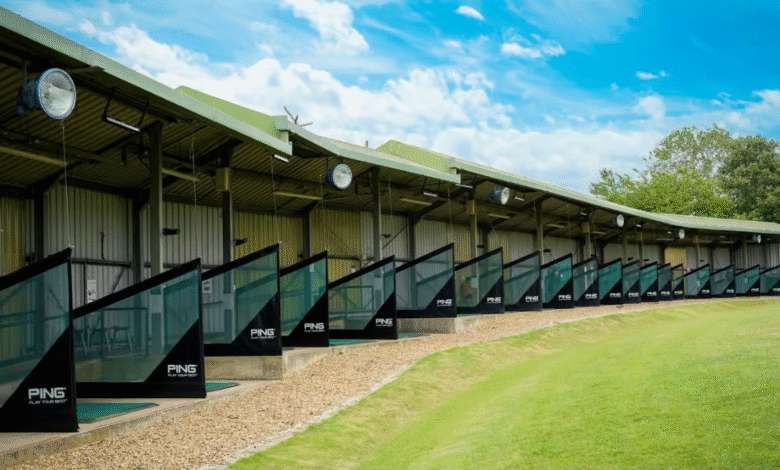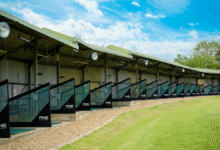Driving Range: The Ultimate Guide to Practice, Fun, and Improvement

Discover everything about the driving range—tips, benefits, etiquette, gear, and expert advice to improve your swing, enjoy practice sessions, and make the most of every visit.
Introduction to the Driving Range
A driving range is more than just a place to hit golf balls; it’s a training ground, a stress reliever, and often the first stepping stone for anyone looking to get into the game of golf. Whether you’re an experienced player fine-tuning your technique or a beginner holding a club for the first time, the driving range offers an accessible, low-pressure environment to practice. It’s the gym for golfers, but instead of weights, you’ve got tees, mats, and rows of balls waiting for your swing.
What makes the driving range so unique is its universal appeal. You don’t need to own expensive clubs or have a tee time booked on a prestigious course to enjoy it. All you need is a bucket of balls, some comfortable shoes, and the willingness to experiment. For many, it’s not just about improving their golf game but also about finding a space to clear their head and enjoy the rhythm of swinging without the distractions of a full course.
Why the Driving Range Matters in Modern Golf
The driving range has become a cornerstone in the world of golf because it bridges the gap between practice and play. On a golf course, you only get one chance at each shot, but on the range, you can repeat the same swing dozens of times until it feels right. That freedom to experiment, without worrying about slowing down other players, is priceless for skill development.
Another reason the driving range matters is accessibility. Not everyone has the time to commit four or five hours to a full round of golf. A quick stop at the driving range during lunch or after work offers the same satisfaction of hitting balls without the time investment. It’s fitness, practice, and entertainment rolled into one short session.
The Driving Range Experience
Stepping onto the driving range is an experience that feels both casual and purposeful. The atmosphere is relaxed—you’ll see golfers of all levels, from complete beginners to scratch players, sharing the same space. Some people arrive in groups, chatting between shots, while others slip on headphones, find their rhythm, and immerse themselves in practice.
Most driving ranges provide a variety of targets—flags, nets, or even mock greens—so you can practice different distances. The sound of golf balls being struck fills the air, punctuated by the occasional cheer when someone hits a particularly sweet shot. There’s no pressure to keep score or move at a certain pace; the focus is purely on you, the ball, and your swing.
Benefits of Spending Time at the Driving Range
The benefits of spending time at the driving range extend far beyond golf itself. For many, it’s about improvement, but for others, it’s about enjoyment, exercise, or even relaxation.
One of the biggest advantages is skill development. You can test different clubs, adjust your stance, and practice specific shots until they feel natural. Regular visits help build muscle memory, which translates directly to better performance on the course. At the same time, the driving range offers a safe space for beginners to learn without the pressure of competition or keeping up with faster players.
On the other hand, the range is also a surprisingly effective stress reliever. The repetitive motion of swinging, combined with the satisfaction of watching the ball soar, can melt away tension. For those with busy lives, a bucket of balls and half an hour at the range can feel like therapy.
Driving Range Etiquette
Like any shared space, the driving range has its own unspoken rules of etiquette. While it’s more relaxed than a formal course, being respectful of others ensures everyone has a good time.
One of the most important practices is to be mindful of spacing. Give the person next to you enough room to swing freely without feeling crowded. It’s also good etiquette to avoid excessive noise—chatting is fine, but blasting music or distracting someone mid-swing isn’t appreciated. Always return baskets and respect staff instructions, since driving ranges rely on smooth operation to keep things enjoyable.
Another piece of etiquette often overlooked is the pace of practice. It’s fine to take your time, but don’t monopolize mats when the place is crowded. A little courtesy goes a long way toward keeping the driving range a welcoming environment.
Essential Gear for the Driving Range
You don’t need a full set of clubs to enjoy the driving range, but a few pieces of gear can make your experience better. At the very least, a driver, a couple of irons, and a wedge are enough to cover most practice needs. Many ranges even offer rental clubs, so beginners don’t need to invest heavily right away.
Beyond clubs, comfortable shoes are key. While golf shoes offer the most stability, sneakers with good grip work just fine for casual practice. Gloves can help prevent blisters during long sessions, and a water bottle is always smart to bring along. While not essential, a small notebook or app to track progress can be surprisingly useful, allowing you to measure improvement over time.
Techniques for Effective Practice at the Driving Range
Not all practice is created equal. The most effective use of the driving range involves more than just hitting balls without thought. Structured practice, with clear goals, can transform your time at the range into noticeable progress.
Start with a warm-up using shorter clubs, gradually working your way up to the driver. This helps loosen muscles and prepares your body for longer swings. Focus on form rather than power—smooth, consistent swings are more valuable than occasional booming drives. Try setting mini-challenges, like hitting a certain target consistently, to stay engaged.
Another smart approach is to practice like you’re on the course. Instead of hitting twenty drivers in a row, mix it up—hit an iron, then a wedge, then a driver—just as you would during an actual round. This simulates real game conditions and helps you adapt.
Driving Range vs. Golf Course
It’s easy to think of the driving range as a simplified version of the golf course, but the two serve very different purposes. On the course, you’re dealing with uneven lies, wind, and the mental pressure of keeping score. The driving range, by contrast, provides controlled conditions where you can isolate and work on specific elements of your game.
That said, the driving range can’t fully replicate the course experience. There are no bunkers to escape or tricky putts to sink. This is why combining range time with actual play is crucial. Think of the range as a laboratory and the course as the real test—the skills you build in practice must be tested in play to truly develop.
Social Side of the Driving Range

The driving range isn’t just about practice—it’s also a surprisingly social spot. Many ranges double as hangout spaces, with cafes, lounges, or even entertainment features like music, lights, and games. Friends and families gather to take turns hitting balls, creating an atmosphere that’s both fun and inclusive.
Even traditional ranges foster a sense of community. Striking up a conversation with the person at the next bay often leads to shared tips, encouragement, or even lasting friendships. For beginners, this social aspect makes golf less intimidating, turning the driving range into a gateway into the golfing world.
Driving Range as Fitness
Golf might not look like a workout, but a session at the driving range burns calories, builds strength, and improves flexibility. Swinging a club repeatedly engages the core, shoulders, and legs, offering a low-impact workout that complements other forms of exercise. Over time, regular range practice can enhance balance, coordination, and endurance.
For those who don’t enjoy traditional gyms, the driving range offers a more engaging alternative. It combines physical activity with mental focus, making it feel less like exercise and more like a hobby. Plus, being outdoors (or even in well-ventilated indoor ranges) adds an element of fresh air and relaxation that you won’t find on a treadmill.
Quotes About the Driving Range
“The driving range is where golfers are made, not born.”
“Every great round begins with hours of practice on the range.”
“The range is more than practice—it’s therapy with a golf club.”
FAQs about the Driving Range
What is a driving range used for?
A driving range is used to practice golf swings, improve accuracy, and enjoy casual sessions without the pressure of a full course.
Do I need to bring my own clubs to the driving range?
Not necessarily. Most driving ranges offer rental clubs, making it easy for beginners or casual visitors to join without owning equipment.
How long should I spend at the driving range?
It depends on your goals. For focused practice, thirty to sixty minutes is plenty. For a casual visit, even twenty minutes can be rewarding.
Can the driving range replace playing on a course?
No. The range is excellent for practice, but the real test of golf skills happens on the course. Both complement each other.
Is the driving range good for beginners?
Absolutely. The driving range is the perfect starting point, offering a stress-free environment to learn the basics.
Is the driving range a workout?
Yes. Repeated swings engage multiple muscle groups and improve coordination, balance, and endurance.
Conclusion
The driving range is more than a practice facility—it’s an experience that blends learning, relaxation, and social connection. Whether you’re chasing a lower handicap, unwinding after a long day, or just exploring the game of golf, the range offers a space where anyone can step up, take a swing, and feel the joy of sending a ball into the distance.




